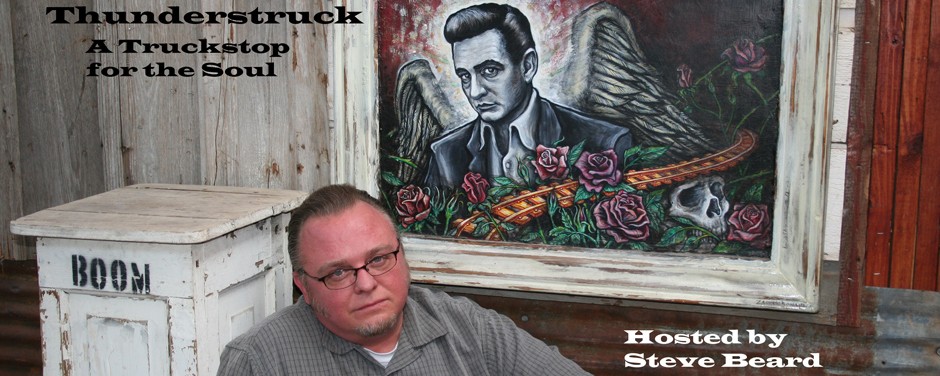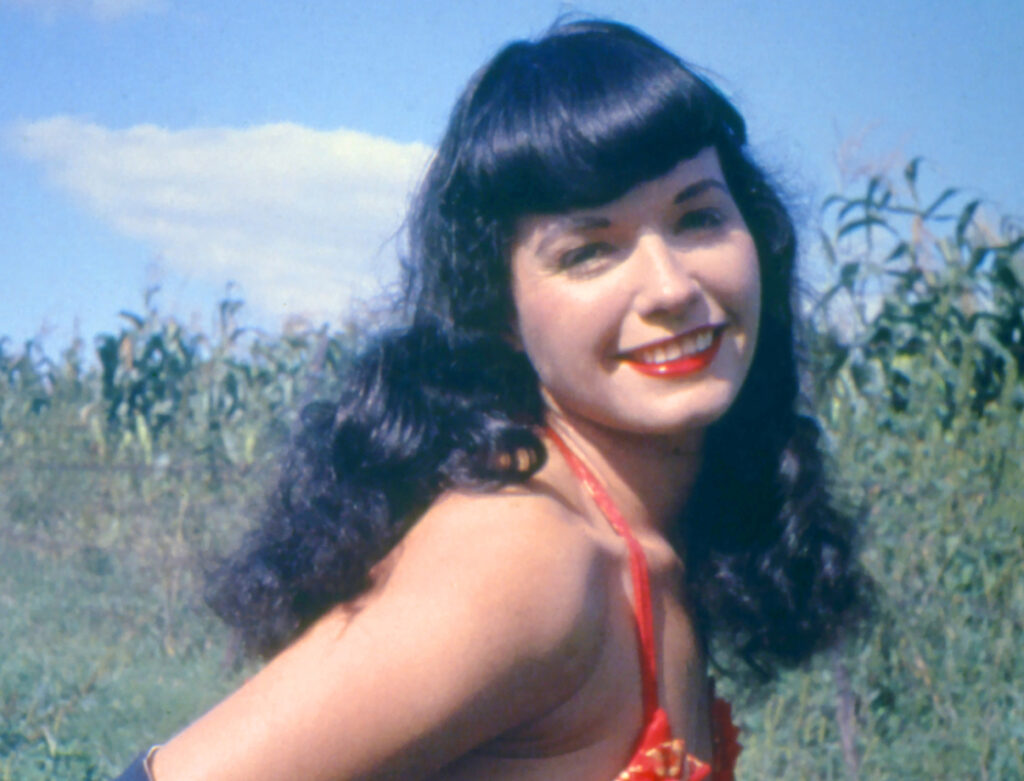By Steve Beard
Ah, those jet-black Bettie Page bangs. Sixty-five years after they were immortalized on a pin-up icon, you still occasionally see them on the pale hipsters with the cat-eyed glasses. That’s just one of the lasting manifestations of Bettie Page’s industrious and enigmatic seven-year modeling career. She was a splash of rockabilly, a dash of Goth, and an extra helping of sass.
Today would have been her 100th birthday.
She died at the age of 85, on Thursday, December 11, 2008. She suffered a heart attack and had been placed on life support, never regaining consciousness. Her funeral was conducted at Pierce Brothers Westwood Memorial Park in Los Angeles by the Rev. Robert Schuller, founding minister of the Crystal Cathedral in Southern California. In attendance, was Page’s longtime friend Hugh Hefner, founder of Playboy magazine (she appeared in the magazine in 1955), and burlesque actress Tempest Storm, who starred with Page in the 1950 film “Teaserama.”
In some ways, Bettie Page is more popular today than she was in the Eisenhower-era. You can purchase her image on playing cards, t-shirts, lunch boxes, beach towels, lighters, key chains, and fridge magnets. There are even a few Bettie Page action figures.
Her legendary status was captured on the silver screen in the 2005 film “The Notorious Bettie Page.” It attempted to chronicle the unlikely life of a religious Southern girl who, arriving in New York City in 1950, becomes a world-famous pin-up. Her scantily-clad image appeared in magazines such as Escapade, Wink, Titter, Eyeful, and Playboy. At that time, she was a hit with the underground photo enthusiasts.
It didn’t matter if she was posing with a leopard skin bikini or a tight leather corset, she had a bright and playful smirk of innocence as though she were at a costume party with spiked punch.
“In her trademark raven bangs, spike heels and killer curves, Ms. Page was the most famous pinup girl of the post-World War II era, a centerfold on a million locker doors and garage walls,” reported the New York Times at her death.
According to Bettieophiles, she had more magazine appearances than Marilyn Monroe and Cindy Crawford combined. In 1957, however, she suddenly disappeared and never again appeared for any photo shoot.
In whatever way the vanishing act may have added to her mystique, the effect was unintentional. Bettie simply didn’t want to model anymore. There were too many stalkers and weirdoes. In 1955, Page even found herself the target of a congressional investigation on the matter of juvenile delinquency.
World-famous Bettie never had a manager, stylist, publicist, or lawyer. She never dated anyone famous and even declined the offer to meet with fans such as Howard Hughes. The one characteristic that marked Bettie Page – aside from her figure – was her independent streak.
For nearly forty years, no one knew what happened to her. She simply disappeared from public view. Journalists Karen Essex and James L. Swanson were the first to track her down and publish her authorized biography, “Bettie Page: The Life of a Pin-Up Legend” in 1996. What happened after her modeling career only makes her more fascinating.
There is a poignant scene in the film “The Notorious Bettie Page” when she is asked by a photographer, “What do you think Jesus would say about what you are doing now?” Having been raised in church, Bettie Page (played by Gretchen Mol) responds, “I hope that if he is unhappy with what I am doing he’ll let me know somehow.”
In real life, Bettie experienced a life-changing epiphany. Page was walking on the beach in Key West on New Years Eve, 1959. “Suddenly, as if taken by the hand, I crossed the street. I looked up and there was a little white church with a white neon cross burning over the top. The doors were open and I heard singing. I was compelled to go in. I sat down in the back, and the minister started delivering a salvation sermon for my benefit, I know,” she recalls in Essex and Swanson’s book.
From that evening, Bettie “concluded that the missing element in her life was a spiritual one.” She began attending that church and was befriended by a Sunday school teacher from Akron, Ohio, who contributed to Bettie’s interest in the Good Book.
Over the following three years after that event, Page attended the Bible Institute of Los Angeles (Biola), the Moody Bible Institute in Chicago, and the Multnomah School of the Bible in Portland, Oregon. For several summers, she attended the Winona Lake Bible Conference in Indiana founded by the flamboyant evangelist Billy Sunday.
While she was living in Chicago, she was a counselor at a massive Billy Graham Crusade. “I’m more proud of my work with the crusade than of anything else I’ve ever done,” she told the Los Angeles Times. “I get emotional just thinking about it. If ever there was a man of God, it’s Billy Graham.”
She wanted to be a missionary and applied to various mission boards but was rejected – not because she had been a fetish pin-up, but because she had been divorced. She spent the rest of her life living quietly and happily in obscurity, working as a secretary, a teacher, and then eventually living modestly off of Social Security. She had no idea that the world was intrigued by her whereabouts until much later in life.
She never changed her name, or her famous hairstyle. When she was asked if she was Bettie Page, she would playfully reply, “Who’s that?” “I was never trying to keep away from people, I was just through with modeling and went on to other things,” she told Essex and Swanson. “I went right on living my life in the open all the time.” She had many difficulties later on in life.
Her raven hair turned gray. Bettie Page shunned the cameras, choosing instead to be remembered as the bombshell of her younger years.
“I was not trying to be shocking, or to be a pioneer,” she once wrote. “I wasn’t trying to change society, or to be ahead of my time. I didn’t think of myself as liberated, and I don’t believe that I did anything important. I was just myself. I didn’t know any other way to be, or any other way to live.”

